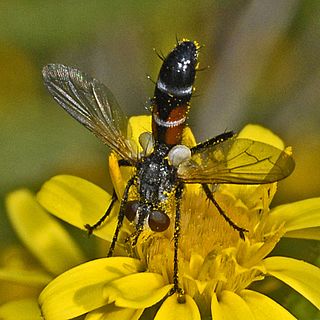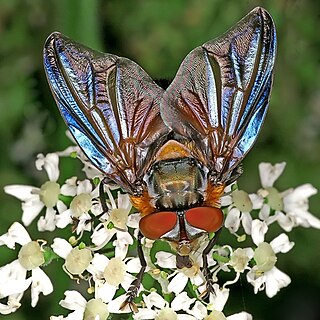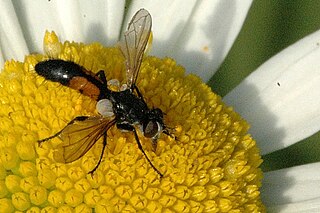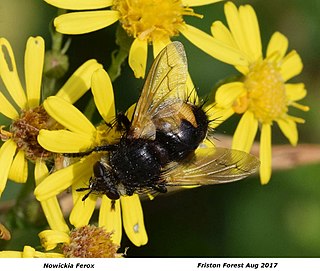
The Tachinidae are a large and variable family of true flies within the insect order Diptera, with more than 8,200 known species and many more to be discovered. Over 1,300 species have been described in North America alone. Insects in this family commonly are called tachinid flies or simply tachinids. As far as is known, they all are protelean parasitoids, or occasionally parasites, of arthropods, usually other insects. The family is known from many habitats in all zoogeographical regions and is especially diverse in South America.

Phasia hemiptera is a fly belonging to the family Tachinidae.

Gymnosoma nudifrons is a species of fly in the family Tachinidae.

Cylindromyia is a genus of flies in the family Tachinidae.
Myxexoristops is a genus of flies in the family Tachinidae.

Lydella is a genus of flies in the family Tachinidae. Lydella thompsoni can be used in the UK for the biological control of the European corn borer.

Tachina fera is a species of fly in the genus Tachina of the family Tachinidae. It was first described by Carl Linnaeus in 1761.

Gymnosoma clavatum is a species of tachinid flies in the genus Gymnosoma of the family Tachinidae.

Trichopoda pennipes is a species of feather-legged fly in the dipteran family Tachinidae.
Hubneria affinis is a species of bristle fly in the family Tachinidae. It parasitizes moths such as Arctia caja by laying eggs in the larvae that eventually kill the host.

Phasiinae is a subfamily of flies in the family Tachinidae. Except for the small tribe Strongygastrini members of this subfamily attack only Heteroptera.

Cylindromyiini is a tribe of flies in the family Tachinidae. It contains about 17 genera and 200 species.

Exorista larvarum is a Palaearctic species of fly in the family Tachinidae.

Compsilura concinnata is a parasitoid native to Europe that was introduced to North America in 1906 to control the population of an exotic forest, univoltine, spongy moth named Lymantria dispar. It is an endoparasitoid of larvae and lives with its host for most of its life. Eventually the parasitoid ends up killing the host and occasionally eating it. It attacks over 200 host species, mainly insects from the Orders: Coleoptera, Lepidoptera and Hymenoptera. Since this parasite has the ability to attack many different types of hosts, the organism has spilled over from the intended forest systems into other areas, like agricultural fields, affecting cabbage pests including the cabbage looper (Trichoplusia); the cabbage worm ; and even other invasive species such as the brown-tail moth. However, it also attacks native, non-pest insects such as the Cecropia moth and American moon moth.

Cylindromyia interrupta is a species of fly in the family Tachinidae.

Cylindromyia brassicaria is a species of fly in the family Tachinidae.

Nemoraea pellucida is a species of fly in the family Tachinidae.

Nemorilla floralis is a species of tachinid fly.

Tachina (Nowickia) ferox is a species of fly in the family Tachinidae first described by Georg Wolfgang Franz Panzer in 1809.

Phania speculifrons is a species of fly in the family Tachinidae.


















